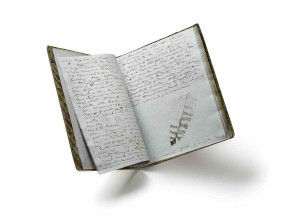Yiddish Book Center Celebrates 150 Years of Modern Jewish Creativity

Left to right: Martin Haake, Yiddishland (detail), 60-foot illustrated mural, 2023; Yiddish typewriter, Hermes “Baby” model (Switzerland), 1941; A Collection of Jewish Songs for Violin, Hebrew Publishing Company (New York), 1914.
The Yiddish Book Center presents a major new core exhibition that explores a multi-faceted international story of identity, creativity, migration, and belonging. Yiddish: A Global Culture opens on October 15, 2023, expanding the Center’s scope to include the world’s first comprehensive museum of modern Yiddish culture.
The exhibition shares the stories of hundreds of the Center’s more unusual books, from detective fiction to modernist poetry, political memoirs, and hand-colored art books. Highlights include:
- fragments of Nobel Prize-winner Isaac Bashevis Singer’s first work, The Salamander, a literary journal he compiled as a young man that was only recently rediscovered in the shtetl of Bilgoray, Poland
- a scrapbook and photograph album created in 1947 by a young Yiddish actor named Harry Ariel in a Displaced Persons camp in Austria
- a wooden box from 1911 containing handwritten index cards detailing the personal Yiddish library of Samuel Judin, an immigrant tailor in America, miraculously reunited with nine books from his library that were donated separately from Hebrew College, Newton, MA.
“Culture matters. If you don’t have access to the stories, the language, and the tangible objects, you can’t truly know who you are,” said Aaron Lansky, founder and president of the Center. “The Yiddish Book Center was founded to recover Yiddish books, but we quickly realized that we also needed to bring stories to the forefront of our work, not just those contained in the books we saved, but narratives about the people, places, and events that gave rise to this mighty literature and culture.”
An immersive experience, the exhibition tells the diasporic story of modern Yiddish literature, theater, music, press, and politics through approximately 350 objects, including rare books, artwork, photographs, sheet music, Yiddish typewriters, and memorabilia. Global in scope, yet deeply personal with many prized heirlooms donated by families over the past 40 years, the exhibition honors both the creators and the consumers of Yiddish culture.
“Yiddish is about much more than nostalgia or an old-world culture. This new core exhibition will present Yiddish as a transnational phenomenon with a unique global footprint, a bridge to modernity for a migrant people, and a sophisticated fusion culture in constant dialogue with the world around it,” said Susan Bronson, executive director of the Yiddish Book Center.
Yiddish: A Global Culture displays artifacts from the Center’s collections or on special loan, all shown in public for the first time. The exhibition offers themed displays on topics including Yiddish Theater, Soviet Yiddish, Modernism, Bestsellers, and Women’s Voices, as well as broader cultural topics such as Press & Politics, Celebrities, and Yiddish and the Holocaust.
“Assembling this exhibition has been a five-year global treasure hunt to find rare artifacts that reflect the endless curiosity and engagement of the Yiddish imagination, from Poland and Russia to Argentina, Egypt, Japan, China and Australia,” said David Mazower, the Center's research bibliographer and editorial director, who is the exhibition’s chief curator. “Yiddish: A Global Culture makes a case for Yiddish as a sophisticated, world culture, on a par with any other, and in the thick of intellectual and creative life in Europe and the Americas.”
Other historic items of note in Yiddish: A Global Culture include:
- a child’s souvenir book of autographs from actors in Maurice Schwartz’s Yiddish Art Theater company when it visited the Boston area in 1939–40
- an enormous hand-drawn 1945 micrographic portrait of Yiddish activist Chaim Zhitlowsky, composed of thousands of miniature letters from his selected texts, created in Buenos Aires by immigrant textile worker Guedale Tenenbaum
- a well-worn leather medicine ball, used by the popular Yiddish novelist Sholem Asch when he relocated to the United States in the 1940s
- puppets from the avant-garde Yiddish marionette theater Modicut, whose topical and satirical sketches fused Jewish tradition with radical politics
- vintage clothes and a leather steamer trunk from the 1920s that was used by the celebrated Yiddish literary couple Peretz Hirshbein and Esther Shumiatcher on their decade-long travels around the world
Visitors can explore a re-creation of the turn-of-the-century Warsaw apartment of writer I. L. Peretz, whose legendary salon stood at the forefront of Yiddish modernism in the 1900s and 1910s. The period reproduction features books, profiles of writers and artists in Peretz’s Circle, a soundscape of voices from the salon, a re-creation of Peretz’s desk, and wallpaper based on original photographs.















